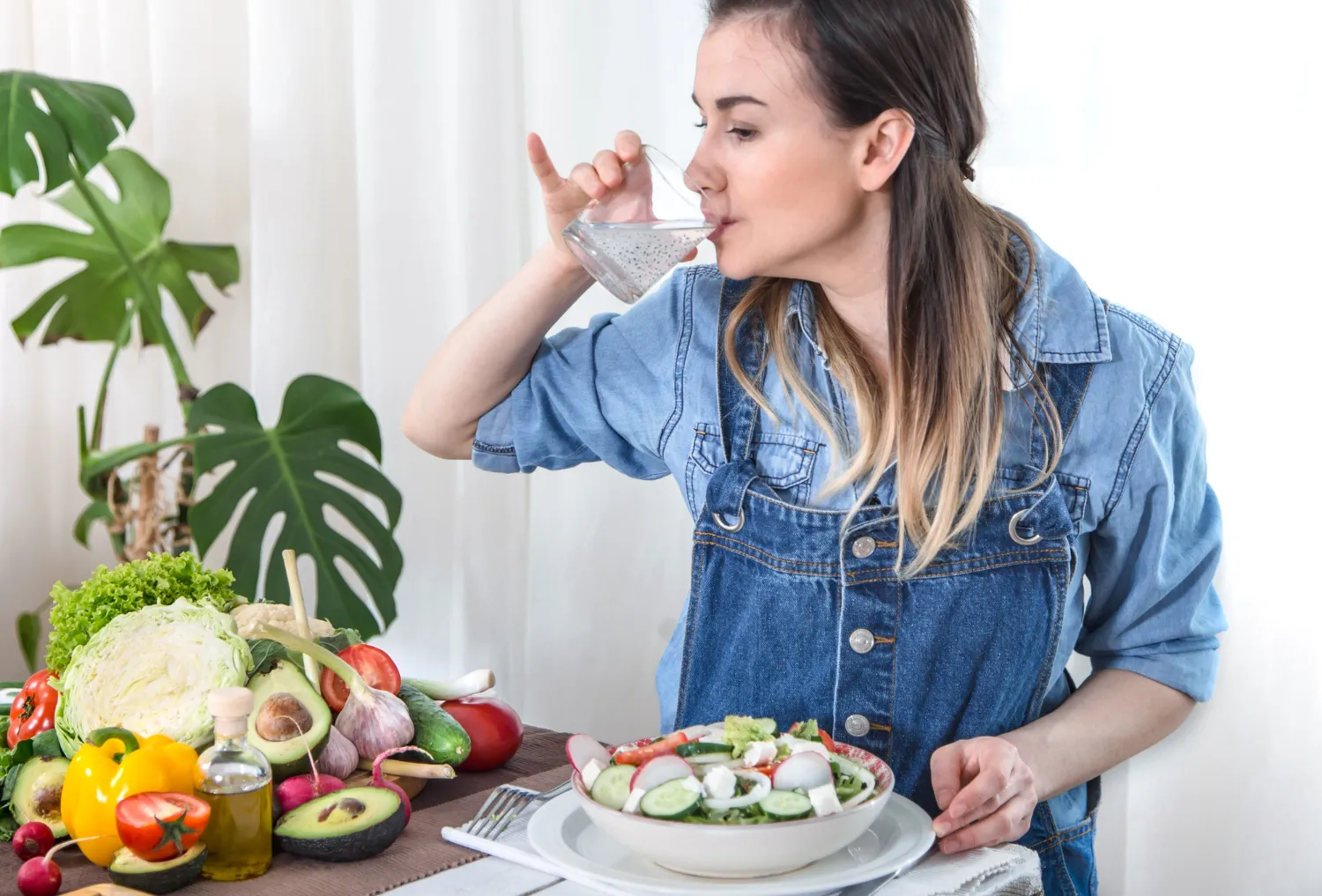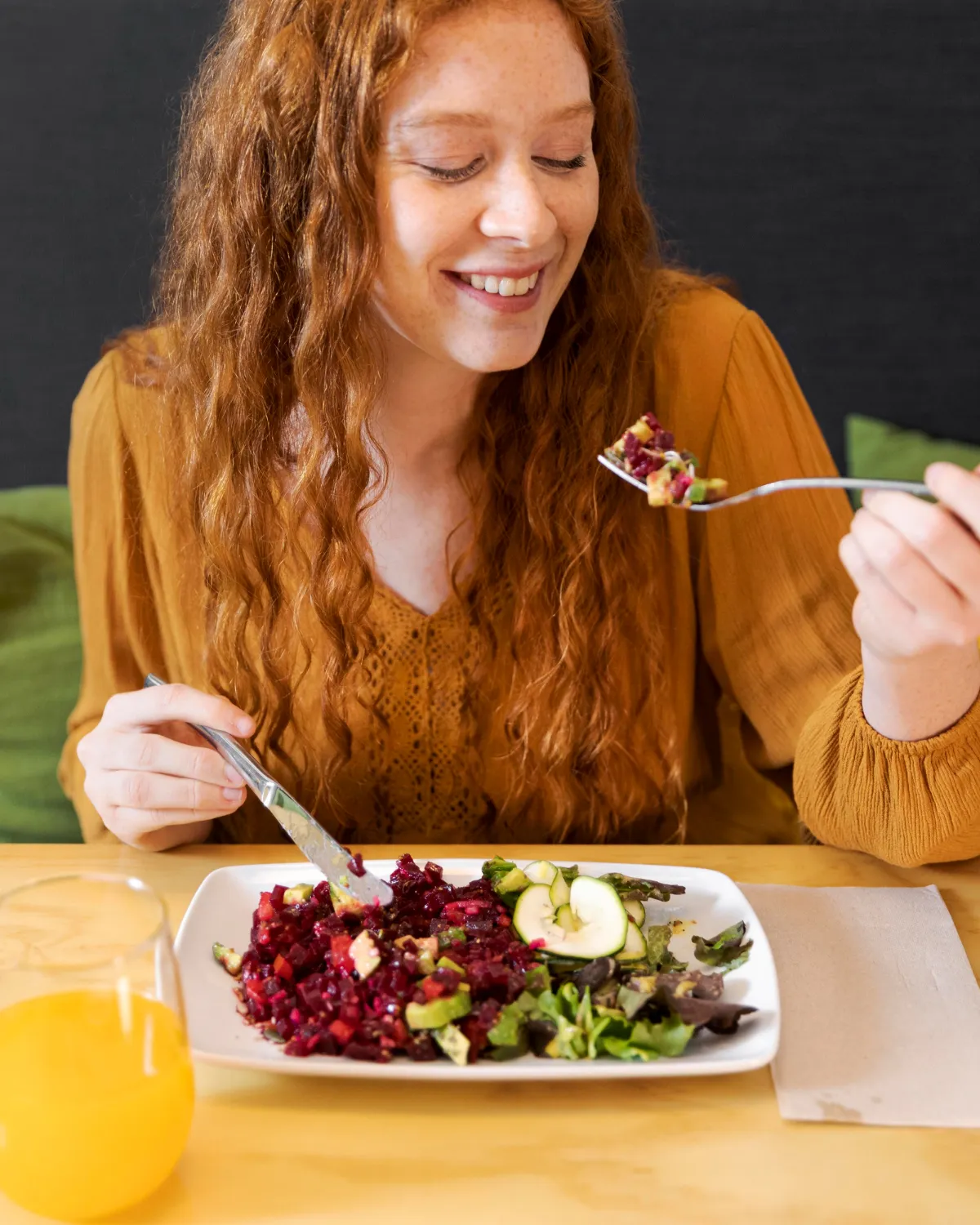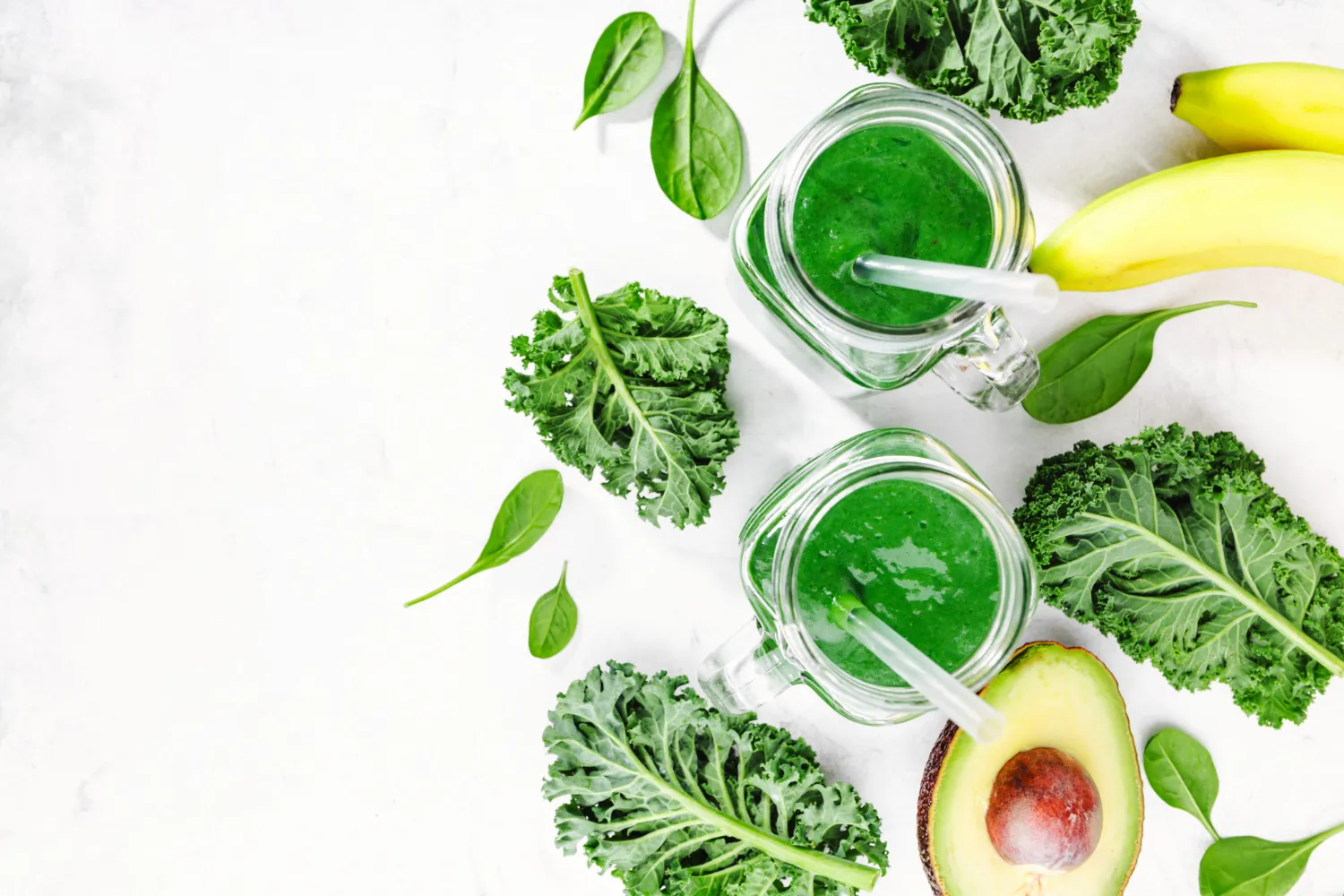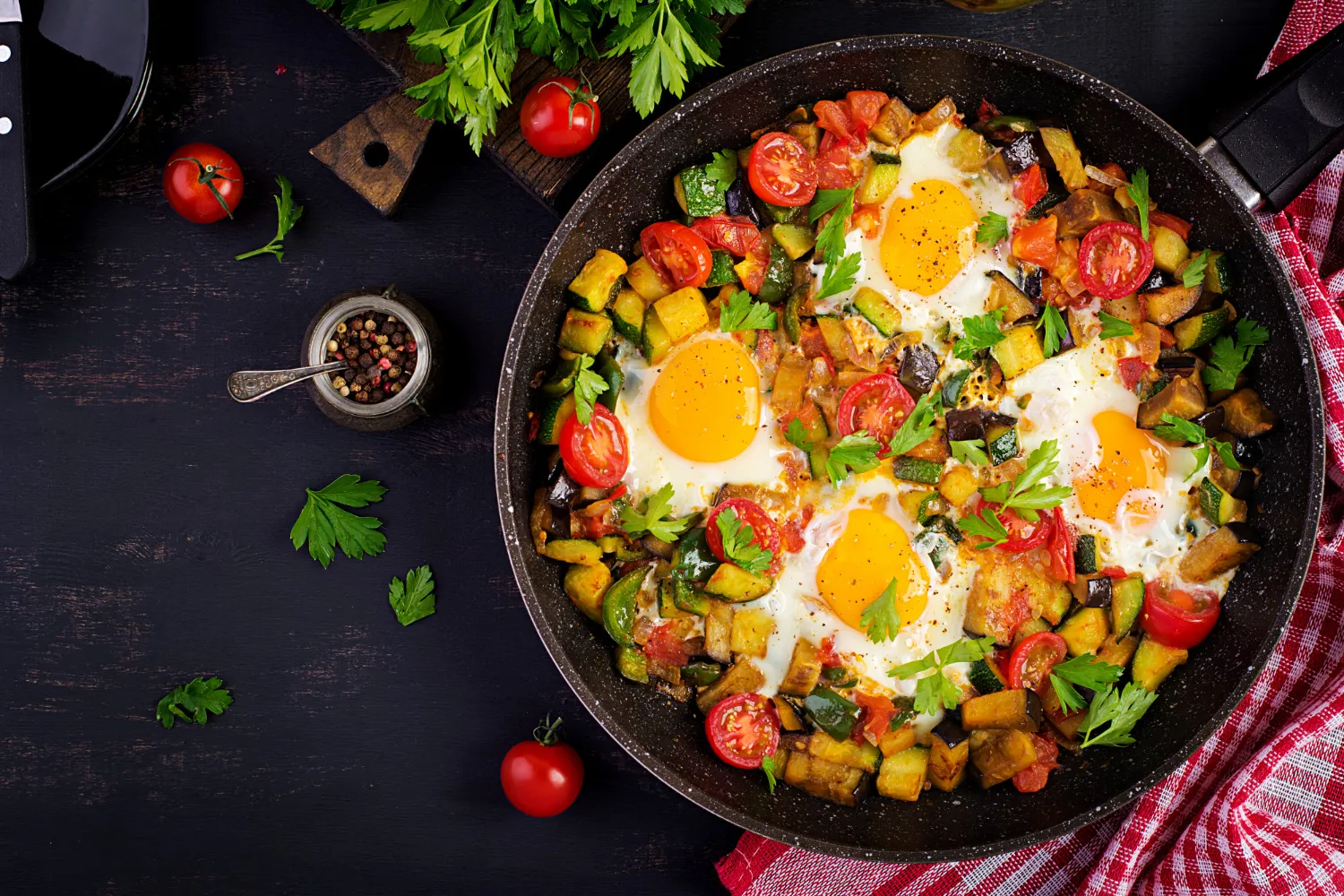The alkaline diet has been touted as the magic diet that alters the body’s pH balance, reducing acidity to prevent disease and improve overall health.
However, there is limited evidence to support these claims, but it does not mean the diet should be written off, as alkaline foods are nutrient-dense and contain anti-inflammatory properties that support midlife metabolism, energy, and enhance overall health.
In this article, we explore the 7-day alkaline diet plan for women. We discuss how it works, key foods, potential challenges, calorie recommendations, and more.
What Is the Alkaline Diet and Does It Work?

The alkaline diet is the practice of consuming certain foods to change the pH level of the body.
After digestion, it is believed that food leaves and “ash” residue that is either acidic or basic, which alters the pH levels of the body.
During the diet, alkaline-producing foods such as fruits, nuts, legumes, and vegetables are prioritized, while acidic foods such as meat, poultry, fish, dairy, grains, eggs, and alcohol are avoided.
While the premise is interesting, there is little evidence to support these claims. This is because pH levels in our body can vary, and food does not affect the pH level.
For example, sources show that stomach acid is highly acidic with a pH level of 1.35–3.5 for digestion, while skin is a little less acidic, sitting at a pH level of 4-6.5 to form a protective layer, and cerebrospinal fluid that surrounds the brain and spinal cord has a pH of 7.3. These pH levels are maintained to protect the body and support digestion.
Foods to Focus on in an Alkaline Meal Plan
Several foods should be the focus of your alkaline meal plan. These foods are whole foods, which are said to be why people see improvements in health during the alkaline diet.
Your 7-Day Alkaline Diet Meal Plan
This 7-day alkaline diet meal plan contains three meals and one snack each day. Each food is listed with calorie content, with the benefits gained from whole foods.
Several of the foods included in this diet are alkaline, however, we will only list the benefits obtained through consuming whole foods as there is little evidence to support the alkaline diet.
Below, we also list the formula and example for calculating your basal metabolic rate (BMR) to show your daily calorie allowance. This data will then be broken down into macronutrients to form a balanced diet.
BMR Formula
- BMR = 10 x weight (kg) + 6.25 x height (cm) - 5 x age (years) - 161
Using this formula, we will share an example of how it is used. Here we calculate the BMR for a 48-year-old woman who is 170 cm tall and weighs 80 kg.
- 10 x 80 + 6.25 x 170 - 5 x 48 - 161
- 800 + 1062.5 - 240 - 161 = 1461.5 kcal/day
To simplify calculations, we will round this figure down to 1450 kcal/day
These are our macronutrient recommendations, which will then be used for your diet plan. There is no set macronutrient ratio for the alkaline diet, meaning you can adjust it to suit traditional or low-carb diets.
- Carbohydrate: 50% of daily calorie intake
- Protein: 20% of daily calorie intake
- Fat: 30% of daily calorie intake
Day 1 — Leafy Greens and Lemon Water Start

Breakfast – Green Power Smoothie Bowl (400 kcal)
- Unsweetened almond milk (30 kcal)
- ½ cup frozen spinach (20 kcal)
- Frozen banana (small) (90 kcal)
- ¼ avocado (medium) (60 kcal)
- 1 tbsp chia seeds (60 kcal)
- 1 scoop plant protein powder (100 kcal)
- 1 tbsp almond butter (49 kcal)
- 1 tsp lemon juice (4 kcal)
Benefits: This meal combines potassium-rich banana, fiber-dense greens, and omega-3-rich chia seeds with healthy fats from avocado and almond butter. It provides slow-release energy and supports digestion with naturally occurring prebiotic fiber.
Lunch – Quinoa, Chickpea & Kale Salad (400 kcal)
- ½ cup cooked quinoa (110 kcal)
- ½ cup cooked chickpeas (120 kcal)
- 1 cup shredded kale (massaged with lemon) (30 kcal)
- ½ cup Cucumber (8 kcal)
- Roasted carrots (10 kcal)
- 1 tsp tahini (30 kcal)
- 1 tsp olive oil (40 kcal)
- 1 tbsp pumpkin seeds (60 kcal)
- Fresh herbs, lemon juice, garlic, cumin (2 kcal)
Benefits: This bowl packs plant-based protein, complex carbs, and healthy fats in a satisfying and crunchy texture. The chickpeas and quinoa offer fiber and iron, while kale and pumpkin seeds contribute magnesium, vitamin K, and trace minerals important for cellular health.
Dinner – Sweet Potato & Lentil Nourish Bowl (400 kcal)
- ¾ cup roasted sweet potato cubes (135 kcal)
- ½ cup cooked green lentils (115 kcal)
- 1 cup steamed broccoli & zucchini (mixed) (60 kcal)
- ¼ avocado (medium)(60 kcal)
- 1 tsp hemp seeds (16 kcal)
- 1 tsp olive oil (40 kcal)
- Fresh lemon, garlic, parsley drizzle (4 kcal)
Benefits: Lentils and sweet potatoes provide a balanced dose of fiber and plant protein, supporting gut health and blood sugar control. The vegetables offer antioxidants, while hemp seeds and olive oil provide heart-healthy fats.
Snack – Apple, Flax & Greens Smoothie Shot (250 kcal)
- Apple (small) (80 kcal)
- 1 cup baby spinach (7 kcal)
- ½ small frozen banana (45 kcal)
- 1 tbsp ground flaxseed (55 kcal)
- 1 tsp almond butter (30 kcal)
- 1 tsp pumpkin seeds (16 kcal)
- ½ cup almond milk + lemon juice splash + cinnamon (17 kcal)
Benefits: This snack delivers fiber, healthy fats, and antioxidants in a portable, refreshing way. The apple and flax combo supports regular digestion, while seeds and nut butter provide satiation and micronutrients like zinc and magnesium.
Day 2 — Alkaline Bowls with Quinoa and Vegetables
Breakfast – Green Quinoa Smoothie Bowl (400 kcal)
- ½ cup cooked quinoa (110 kcal)
- 1 cup unsweetened almond milk (30 kcal)
- ½ cup frozen spinach (20 kcal)
- 1 small frozen banana (90 kcal)
- ¼ fruit avocado (60 kcal)
- 1 tbsp chia seeds (60 kcal)
- ½ scoop plant protein powder 60 kcal
- 1 tsp almond butter (35 kcal)
- Cinnamon & lemon zest (0 kcal)
Benefits: Combines slow‑burning carbs, plant protein, and omega‑rich seeds to keep energy steady all morning.
Lunch – Chickpea‑Quinoa Kale Bowl (400 kcal)
- ⅓ cup cooked quinoa (73 kcal)
- ½ cup cooked chickpeas (120 kcal)
- ½ cup roasted sweet‑potato cubes (90 kcal)
- 1 cup shredded kale (30 kcal)
- ½ cup cucumber (8 kcal)
- ¼ avocado fruit (60 kcal)
- 1 tsp extra‑virgin olive oil (40 kcal)
- 1 tsp tahini‑lemon‑garlic drizzle (30 kcal)
- Fresh herbs & cumin (2 kcal)
Benefits: Offers a hearty mix of fiber, minerals, and healthy fats that supports satiety and balanced blood sugar through the afternoon.
Dinner – Rainbow Veggie & Quinoa Stir‑Bowl (400 kcal)
- ⅓ cup cooked quinoa (73 kcal)
- ½ cup shelled edamame (95 kcal)
- 1 cup steamed broccoli (55 kcal)
- ½ cup sliced red bell pepper (15 kcal)
- ½ cup roasted carrot (25 kcal)
- ⅛ avocado fruit (30 kcal)
- 1 tbsp hemp seeds (55 kcal)
- 1 tsp extra‑virgin olive oil (40 kcal)
- Splash tamari, ginger, lime juice (10 kcal)
Benefits: Delivers a colorful array of antioxidants and complete plant protein, while the healthy fats aid absorption of fat‑soluble vitamins.
Snack – Apple‑Flax Crunch Duo (250 kcal)
- Small apple (80 kcal)
- 1 tbsp ground flaxseed (55 kcal)
- 1 tbsp almond butter (90 kcal)
- 1 tsp pumpkin seeds (16 kcal)
- Celery sticks (10 kcal)
Benefits: Combines crisp fruit fiber with satisfying nuts and seeds to curb hunger and provide a boost of micronutrients between meals.
Day 3 — Colorful Salads and Herbal Teas

Breakfast – Zucchini Oat Pancakes with Berries & Herbal Tea (400 kcal)
- ½ cup rolled oats (150 kcal)
- ½ cup shredded zucchini (10 kcal)
- 1 tbsp flaxseed meal (37 kcal)
- ½ cup almond milk (15 kcal)
- 1 tsp maple syrup (17 kcal)
- 1 tsp olive oil (for cooking) (40 kcal)
- ½ cup mixed berries (35 kcal)
- 1 tbsp) pumpkin seeds (60 kcal)
- 1 tbsp cinnamon + nutmeg (0 kcal)
- Peppermint tea (0 kcal)
Meal Benefit: Combines soluble fibre, healthy fats, and antioxidants to nourish the gut and heart while keeping energy steady.
Lunch – Rainbow Salad with Lentils, Quinoa & Tahini-Lime Dressing (400 kcal)
- ½ cup cooked green lentils (115 kcal)
- ½ cup cooked tri-colour quinoa (110 kcal)
- ½ cup cherry tomatoes (15 kcal)
- ¼ cup grated carrots (12 kcal)
- ¼ cup sliced cucumber (4 kcal)
- ½ cup chopped red cabbage (11 kcal)
- ⅛ avocado (30 kcal)
- 1 tbsp Tahini (89 kcal)
- Lime juice + cumin + parsley (4 kcal)
Benefits: A colourful fibre-rich combo of legumes, seeds, and vegetables that supports digestion and provides a variety of minerals.
Dinner – Roasted Veggie Bowl with Millet & Cashew-Herb Sauce (400 kcal)
- ½ cup cooked millet (110 kcal)
- ¾ cup roasted broccoli (50 kcal)
- ½ cup roasted red pepper (20 kcal)
- ½ cup roasted butternut squash (45 kcal)
- Cashew-herb sauce (1 tbsp soaked blended cashews + parsley + lemon juice) (85 kcal)
- 1 tsp olive oil (40 kcal)
- 1 tsp sunflower seeds (30 kcal)
- 1 tsp chamomile tea (0 kcal)
Benefits: This meal supports muscle and mood with magnesium-rich whole grains and warm, satisfying plant diversity.
Snack – Apple Chia Parfait with Almonds (250 kcal)
- 1 small chopped apple (80 kcal)
- ½ cup coconut yogurt, unsweetened (60 kcal)
- 1 tbsp chia seeds (60 kcal)
- 1 tbsp slivered almonds (50 kcal)
- Dash of cinnamon (0 kcal)
Benefits: A satisfying combination of crunch, fibre, and plant-based fats that helps curb appetite and keep you balanced.
Day 4 — Root Veggies, Greens, and Nuts
Breakfast – Sweet‑Potato & Spinach Power Hash (400 kcal)
- 1 ¼ cups roasted sweet‑potato cubes (130 kcal)
- 1 cup sautéed baby spinach (10 kcal)
- ¼ cup cooked quinoa (55 kcal)
- 1 tbsp chopped walnuts (70 kcal)
- 1 tbsp pumpkin seeds (60 kcal)
- ⅛ avocado fruit (30 kcal)
- 1 tsp extra‑virgin olive oil (40 kcal)
- Squeeze of lemon + herbs (5 kcal)
Benefits: Provides steady morning fuel with complex carbs, plant protein, and omega‑rich nuts and seeds.
Lunch – Beet, Lentil & Quinoa Rainbow Salad (400 kcal)
- ½ cup cooked red beet cubes (37 kcal)
- ½ cup cooked green lentils (115 kcal)
- ⅓ cup cooked quinoa (73 kcal)
- ⅓ cup arugula 1 cup (5 kcal)
- Cucumber half‑cup slices (8 kcal)
- ¼ cup shredded carrot (12 kcal)
- ¼ avocado (60 kcal)
- 1 tbsp sliced almonds (60 kcal)
- ½ tsp olive oil (20 kcal)
- 1 tsp pumpkin seeds (15 kcal)
- Lime juice, parsley, cumin (5 kcal)
Benefits: A fibre‑dense mix of legumes, roots, and healthy fats that supports digestion and long‑lasting satiety. Sip a cup of hibiscus‑mint tea (0 kcal) as you enjoy it.
Dinner – Quinoa‑Stuffed Pepper with Parsnip & Kale‑Walnut Pesto (400 kcal)
- Large red bell pepper (roasted) (30 kcal)
- ½ cup roasted parsnip cubes (60 kcal)
- ½ cup cooked quinoa (110 kcal)
- ⅓ cup cooked chickpeas (80 kcal)
- 1 cup finely chopped kale (30 kcal)
- Walnut‑herb pesto (walnuts 2 tsp 45 kcal + olive oil 1 tsp 40 kcal + lemon, garlic) (85 kcal)
Benefits: Delivers complete plant protein, slow carbs, and antioxidant‑rich greens in a comforting, flavour‑packed bowl. Enjoy ginger‑lemongrass herbal tea (0 kcal).
Snack – Apple & Carrot Dippers with Almond‑Chia Spread (250 kcal)
- Small apple, sliced (80 kcal)
- 1 cup carrot sticks (50 kcal)
- 1 tbsp almond butter (90 kcal)
- 1 tsp chia seeds (stirred into almond butter) (20 kcal)
- Dash of cinnamon + tiny honey drizzle (10 kcal)
Benefits: Combines crisp fibre with satiating proteins and fats, perfect for taming mid‑afternoon hunger.
Day 5 — Hydration-Focused, High-Fiber Meals
Breakfast – Hydrating Green Smoothie Bowl (402 kcal)
- 1¼ cups unsweetened coconut water (55 kcal)
- 1 cup cucumber (16 kcal)
- 1 cup frozen spinach (20 kcal)
- ¾ cup frozen mango (70 kcal)
- ½ frozen banana (small) (45 kcal)
- ¼ avocado (60 kcal)
- 1 tbsp chia seeds (60 kcal)
- 1 tbsp hemp seeds (55 kcal)
- 1 scoop plant protein powder (100 kcal)
- Lime juice splash (4 kcal)
Benefits: Floods cells with fluid‑rich produce, fibre, and omega‑3 fats for steady morning energy.
Lunch – Watermelon‑Mint Quinoa Salad (400 kcal)
- ⅓ cup cooked quinoa (73 kcal)
- ½ cup cooked chickpeas (120 kcal)
- 1 cup seedless watermelon cubes (46 kcal)
- ½ cup cucumber (8 kcal)
- ¼ avocado (60 kcal)
- 2 tsp pumpkin seeds (40 kcal)
- 1 tsp olive oil (40 kcal)
- Fresh mint & lime juice (4 kcal)
- Sea‑salt–free citrus zest (0 kcal)
Benefits: Combines ultra‑hydrating fruit and veg with complete plant protein and healthy fats for long‑lasting focus. Enjoy with a chilled hibiscus‑mint tea (0 kcal).
Dinner – Rainbow Quinoa & Edamame Bowl (403 kcal)
- ⅓ cup cooked quinoa (73 kcal)
- ¾ cup shelled edamame (140 kcal)
- 1 cup steamed broccoli florets (55 kcal)
- ½ cup roasted beet cubes (37 kcal)
- ⅛ avocado fruit (30 kcal)
- ½ tsp olive oil (20 kcal)
- 1 tsp hemp seeds (16 kcal)
- 1 tsp pumpkin seeds (20 kcal)
- ½ cup cucumber (8 kcal)
- Lemon‑garlic‑parsley splash (4 kcal)
Benefits: Colourful antioxidants, ample fibre, and plant‑based protein help repair tissue and keep you satisfied through the evening. Sip a mug of ginger‑lemongrass herbal tea (0 kcal).
Snack – Crunchy Veg & Fruit Dipper Plate (245 kcal)
- Small apple (sliced) (80 kcal)
- 1 cup celery sticks (16 kcal)
- ½ cup cucumber rounds (8 kcal)
- 2 tsp almond‑cashew butter (60 kcal)
- 1 tsp ground flaxseed (18 kcal)
- 1 tsp hemp seeds (16 kcal)
- 1 tsp chia seeds (20 kcal)
- ¼ scoop plant protein powder (25 kcal)
- Dash cinnamon & lime zest (0 kcal)
Benefits: Crisp produce plus a seed‑nut blend tames cravings, supports digestion, and tops up minerals between meals.
Day 6 — Light Grains and Alkaline Soups
Breakfast — Creamy Millet‑Berry Bowl (407 kcal)
- ½ cup cooked millet (110 kcal)
- 1 cup unsweetened almond milk (30 kcal)
- ½ cup frozen blueberries (35 kcal)
- ½ banana (small) (45 kcal)
- 1 tbsp chia seeds (60 kcal)
- 1 tbsp hemp seeds (55 kcal)
- 2 tsp pumpkin seeds (20 kcal)
- 1 tsp maple syrup (17 kcal)
- 1 tsp almond butter (35 kcal)
Benefits: Fibre‑rich grains and seeds pair with fruit antioxidants for steady morning energy and satiety.
Lunch — Quinoa & Garden Vegetable Soup (400 kcal)
- 1 cup vegetable broth (10 kcal)
- ⅓ cup cooked quinoa (73 kcal)
- ¼ cup cooked millet (55 kcal)
- ½ cup chickpeas (120 kcal)
- ½ cup diced zucchini (10 kcal)
- ½ cup diced carrot (25 kcal)
- 1 cup baby spinach (7 kcal)
- 1 tsp olive oil (40 kcal)
- ⅛ avocado (30 kcal)
- 1 tsp hemp seeds (16 kcal)
- 1 tsp white miso (10 kcal)
- Lemon juice & parsley (4 kcal)
Benefits: A hydration‑focused soup packed with plant protein, minerals, and vibrant veggies that keeps afternoon energy even.
Dinner — Buckwheat Noodle & Tofu Broth Bowl (414 kcal)
- 1½ oz buckwheat soba noodles (cooked) (150 kcal)
- 1 cup vegetable broth (10 kcal)
- 2 oz firm tofu (50 kcal)
- 1 cup steamed broccoli (55 kcal)
- ½ cup mushrooms (sliced) (10 kcal)
- 1 cup kale (ribbons) (30 kcal)
- 1 tsp sesame oil (40 kcal)
- 1 tbsp pumpkin seeds (55 kcal)
- 1 tsp white miso (10 kcal)
- grated ginger, garlic, lime splash (4 kcal)
Benefits: Delivers warming comfort, complete plant protein, and a spread of phytonutrients to support recovery and calm evening hunger.
Snack — Pear & Nut‑Seed Crunch (261 kcal)
- Pear (medium) (100 kcal)
- 1 cup celery sticks (16 kcal)
- 1 tbsp almond butter (90 kcal)
- 1 tbsp ground flaxseed (55 kcal)
Benefits: Combines crisp produce with healthy fats and fibre to tame cravings and aid gentle digestion between meals.
Day 7 — Citrus-Infused Wrap-Up

Breakfast – Citrus Quinoa & Berry Bowl (400 kcal)
- ¾ cup cooked quinoa (165 kcal)
- ½ cup fresh orange segments (45 kcal)
- ¼ cup blueberries (21 kcal)
- Lemon zest & juice (5 kcal)
- 1 tbsp chia seeds (60 kcal)
- 1 tbsp hemp seeds (55 kcal)
- 1 tsp almond butter (35 kcal)
- ½ cup unsweetened almond milk (14 kcal)
Benefits: This refreshing bowl delivers fiber, healthy fats, and antioxidants, while citrus supports collagen formation and iron absorption.
Lunch – Citrus Greens with Chickpeas & Millet (400 kcal)
- ½ cup cooked millet (110 kcal)
- ½ cup cooked chickpeas (120 kcal)
- 1 cup baby spinach & arugula mix (10 kcal)
- ¼ cup carrot (shredded) (10 kcal)
- ¼ cup cucumber (slices) (5 kcal)
- ⅛ avocado (30 kcal)
- 1 tsp olive oil (40 kcal)
- Lemon juice + orange zest dressing (10 kcal)
- 1 tbsp pumpkin seeds (55 kcal)
- Fresh parsley (5 kcal)
Benefits: A vibrant salad with plant-based protein and whole grains to support blood sugar balance and digestive health.
Dinner – Roasted Root Citrus Bowl with Tahini (400 kcal)
- ¾ cup roasted sweet potato (135 kcal)
- ½ cup roasted parsnip (80 kcal)
- ½ cup steamed kale (18 kcal)
- ½ cup cooked quinoa (110 kcal)
- Lemon-tahini drizzle (tahini 1 tbsp + lemon juice + garlic) (55 kcal)
- Chopped fresh cilantro & lemon zest (2 kcal)
Benefits: This earthy citrus bowl offers warming comfort with grounding root vegetables, fiber, and a boost of vitamin C from the lemon-tahini sauce.
Snack – Citrus Fruit & Seed Mix (250 kcal)
- 1 kiwi (medium, sliced) (42 kcal)
- ½ orange (sliced) (30 kcal)
- 1 medjool date (66 kcal)
- 1 tbsp almonds (70 kcal)
- 1 tbsp flaxseed (ground) (55 kcal)
Benefits: Naturally sweet with crunch and fiber, this snack supports hydration and satiety between meals while delivering potassium and healthy fats.
Potential Challenges with the Alkaline Diet
The alkaline diet’s biggest positive is that it is constructed using nutrient-dense whole foods. However, its focus on alkaline food can make it restrictive, leading to potential challenges. Below, we identify these challenges so you know what to expect when undertaking the alkaline diet.
Nutrient Gaps to Watch For
The alkaline diet’s avoidance of acidic foods such as meat, poultry, fish, dairy, grains, eggs, and legumes can cause major gaps in nutrition.
Animal foods are an incredible source of protein and vitamin B12. Protein is the body’s building block, and is shown to serve as structural support, hormones, enzymes, and building muscle. Meanwhile, sources show that vitamin B12 is vital for nerve function, red blood cell formation, and DNA synthesis.
Limiting dairy can also reduce calcium intake, which sources show can impact bone health, increasing the risk of osteoporosis. While the lack of fatty fish means less omega-3 fatty acids will be consumed, which is shown to result in joint pain, fatigue, mood swings, impaired cognitive function, and an increased risk of cardiovascular problems.
To remedy this, plant-based protein, calcium, and omega-3 must be prioritized, while vitamin B12 will need to be supplemented.
Below, we list food sources for each to help you avoid nutrient deficiencies.
Over-Restriction and Energy Deficiency
Many who try the alkaline diet for the first time can fall into the trap of over-restricting their food intake, which can lead to nutrient deficiencies.
While several foods should be avoided, it does not mean calorie intake should be limited.
To avoid this, we recommend identifying your daily calorie allowance and sticking to it as closely as possible. This, combined with continuous monitoring of potential deficiencies, makes it more sustainable.
Making It Sustainable with Flexibility
The best way to improve sustainability is to be flexible with acid-forming foods such as meat, fish, dairy, and grains. It is recommended that those who follow the alkaline diet consume 75% alkaline-forming foods to 25% acid-forming foods.
While there is little evidence to support the alkaline diet, we understand that many will still want to try to see for themselves. Using this ratio will help to reduce those nutrient deficiencies, making the diet more sustainable.
Recap — How This 7 Day Alkaline Plan Supports Wellness
The evidence to support the alkaline diet is lacking, but it doesn’t stop people all over the world from trying it. If you are considering trying it, we recommend you follow an alkaline diet plan and monitor and supplement your nutrient intake.
For worms entering or experiencing menopause who are experiencing significant symptoms, we recommend speaking to a licensed nutrition practitioner. They will be able to guide you through the process and help you identify potential deficiencies and risks to ensure you are undergoing the diet safely.
More Vegetables, Less Inflammation
Prioritizing vegetables should be one of your top priorities for supporting wellness and reducing inflammation. Research shows that vegetable intake is associated with a lower level of oxidative stress and inflammation, reducing the effect of cardiovascular risk factors.
Meanwhile, further studies highlight their capacity to reduce chronic diseases such as heart disease, stroke, type 2 diabetes, and cancer. To take advantage of these benefits, it is recommended that you consume five or more servings per day.
Better Hydration and Mineral Intake
Like any nutrition plan, hydration and mineral intake are vital to support overall health. Beyond focusing on the previously mentioned nutrient gaps, we recommend drinking 2.2 liters of water each day to stay hydrated.
This will help maintain fluid balance, eliminate waste products, and support overall health.
Energy and Balance Without Extremes
Lastly, ensure that you are meeting your daily energy requirement and hitting your daily macronutrient targets. This will ensure you have enough energy to fuel your daily activities, and cover those nutritional bases, reducing the impact of potential nutrient deficiencies.
Sources
- Schwalfenberg GK. The alkaline diet: is there evidence that an alkaline pH diet benefits health? J Environ Public Health. 2012;2012:727630. doi: 10.1155/2012/727630. Epub 2011 Oct 12. PMID: 22013455; PMCID: PMC3195546. https://pmc.ncbi.nlm.nih.gov/articles/PMC3195546/
- LaPelusa, A. and Kaushik, R., 2022. Physiology, Proteins. In: StatPearls [Internet]. Treasure Island (FL): StatPearls Publishing. https://www.ncbi.nlm.nih.gov/books/NBK563218/
- National Institutes of Health Office of Dietary Supplements, 2024. Vitamin B12: Fact Sheet for Health Professionals. [online] Office of Dietary Supplements, U.S. Department of Health & Human Services. https://ods.od.nih.gov/factsheets/VitaminB12-HealthProfessional/
- National Institutes of Health Office of Dietary Supplements, 2024. Calcium: Fact Sheet for Health Professionals. [online] Office of Dietary Supplements, U.S. Department of Health & Human Services. https://ods.od.nih.gov/factsheets/Calcium-HealthProfessional/
- National Institutes of Health Office of Dietary Supplements, 2024. Omega-3 Fatty Acids: Fact Sheet for Health Professionals. [online] Office of Dietary Supplements, U.S. Department of Health & Human Services. https://ods.od.nih.gov/factsheets/Omega3FattyAcids-HealthProfessional/
- Holt EM, Steffen LM, Moran A, Basu S, Steinberger J, Ross JA, Hong CP, Sinaiko AR. Fruit and vegetable consumption and its relation to markers of inflammation and oxidative stress in adolescents. J Am Diet Assoc. 2009 Mar;109(3):414-21. doi: 10.1016/j.jada.2008.11.036. PMID: 19248856; PMCID: PMC2676354. https://pmc.ncbi.nlm.nih.gov/articles/PMC2676354/
- Boeing H, Bechthold A, Bub A, Ellinger S, Haller D, Kroke A, Leschik-Bonnet E, Müller MJ, Oberritter H, Schulze M, Stehle P, Watzl B. Critical review: vegetables and fruit in the prevention of chronic diseases. Eur J Nutr. 2012 Sep;51(6):637-63. doi: 10.1007/s00394-012-0380-y. Epub 2012 Jun 9. PMID: 22684631; PMCID: PMC3419346. https://pmc.ncbi.nlm.nih.gov/articles/PMC3419346/
FAQs
Does the alkaline diet actually change my body's pH level?
This is a common misconception. It's crucial to understand that the diet does not and cannot change the pH of your blood, which is tightly regulated by your body to a narrow range of 7.35-7.45. The "alkaline" theory relates to the potential "acid load" on your kidneys and body systems. The primary, proven benefit of this diet comes from its core principles: eating more whole plant foods, drinking more water, and drastically reducing your intake of processed junk food, which is undeniably healthy for anyone
What exactly is the alkaline diet and how does it work?
The alkaline diet is an eating pattern based on the idea that certain foods create an "acidic" or "alkaline" effect in the body after they are metabolized. The theory suggests that eating more alkaline-forming foods (like most fruits, vegetables, nuts, and seeds) and fewer acid-forming foods (like meat, dairy, sugar, and processed items) can help reduce the metabolic load on your body, leading to better health and energy levels.
How can an alkaline diet specifically benefit women?
Women may find an alkaline-focused diet particularly beneficial for several reasons. The emphasis on mineral-rich plant foods can help combat inflammation and bloating, which are common concerns. The diet's high intake of leafy greens and vegetables supports bone health by providing calcium and magnesium. Furthermore, by cutting out processed sugars and refined carbs, many women experience more stable energy levels and clearer, more radiant skin.
What are the main alkaline-forming foods in this 7-day meal plan?
This 7-day plan is built around delicious and accessible alkaline-forming foods. You can expect to see a heavy focus on: Vegetables: Especially leafy greens like spinach and kale, as well as broccoli, cucumber, and bell peppers. Fruits: Including lemons, avocados, tomatoes, and berries. Healthy Fats: From sources like almonds, seeds, and olive oil. Alkaline Grains & Legumes: Such as quinoa and lentils.
What results can I realistically expect after completing the 7-day plan?
After 7 days on this alkaline meal plan, you can realistically expect to feel lighter and less bloated due to the high water and fiber content and the reduction in processed foods. Most women report a noticeable increase in energy levels and mental clarity as their blood sugar becomes more stable. You may also see improvements in your digestion and skin complexion. Think of it as a powerful, week-long reset for your body.















